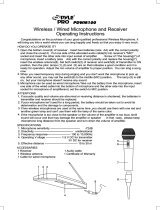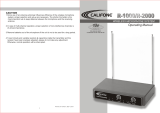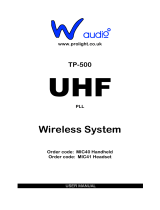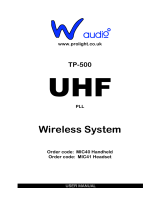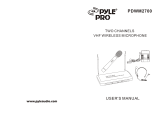
System 9
VHF Wireless System
Installation and Operation
ATW-901
UniPak
®
Transmitter System
ATW-901/G
Guitar System
ATW-901/H
Headworn Microphone System
ATW-901/H92
Miniature Headworn Microphone System
ATW-901/H92-TH
Miniature (beige) Headworn Microphone System
ATW-901/L
Lavalier Microphone System
ATW-902
Handheld Microphone System
PEAK
RF
SYSTEM 9
1 2 3 4
CHANNEL

System 9 Installation and Operation
2
This device complies with part 15 of the FCC Rules. Operation is subject
to the condition that this device does not cause harmful interference.
A copy of the declaration of conformity can be found on the internet at
www.audio-technica.com.
This device complies with INDUSTRY CANADA R.S.S. 210, en
conformité avec IC: RSS-210/CNR210. Operation is subject to the
following conditions: 1) This device may not cause harmful interference
and 2) this device must accept any interference received, including
interference which may cause undesired operation. Changes or
modications not expressly approved by Audio-Technica could void your
authority to operate this equipment.
CAUTION! Electrical shock can result from removal of the receiver
cover. Refer servicing to qualied service personnel. No user-
serviceable parts inside. Do not expose to rain or moisture.
The circuits inside the receiver and transmitter have been precisely
adjusted for optimum performance and compliance with federal
regulations. Do not attempt to open the receiver or transmitter. To do so
will void the warranty, and may cause improper operation.
Notice to individuals with implanted cardiac pacemakers or AICD
devices:
Any source of RF (radio frequency) energy may interfere with normal
functioning of the implanted device. All wireless microphones have
low-power transmitters (less than 0.05 watts output) which are unlikely
to cause difculty, especially if they are at least a few inches away.
However, since a “body-pack” mic transmitter typically is placed against
the body, we suggest attaching it at the belt, rather than in a shirt
pocket where it may be immediately adjacent to the medical device.
Note also that any medical-device disruption will cease when the RF
transmitting source is turned off. Please contact your physician or
medical-device provider if you have any questions, or experience any
problems with the use of this or any other RF equipment.
Thank you for choosing an Audio-Technica professional wireless
system. You have joined thousands of other satised customers who
have chosen our products because of their quality, performance and
reliability. This wireless microphone system is the successful result of
years of design and manufacturing experience.
Audio-Technica’s System 9 is a four-channel frequency-agile wireless
system designed to provide rock-solid performance along with
easy setup and clear, natural sound quality. Featuring stackable,
contemporary styling, System 9 is available in handheld, headworn,
guitar, lavalier and body-pack congurations. The system offers four
compatible user-switchable channels in one of four available VHF
frequencies (169.505, 170.245, 171.045, and 171.905 MHz).
Each System 9 professional VHF wireless system includes a receiver
and either a body-pack transmitter or a handheld microphone/
transmitter. ATW-901 UniPak
®
body-pack transmitter systems include
models pre-packaged with either an AT-GCW guitar cable (/G), a
PRO 8HEcW headworn microphone (/H), a PRO 92cW headworn
microphone (/H92), a PRO 92cW-TH headworn microphone
(/H92-TH), or a lavalier mic (/L) for particular applications. All A-T
Wireless Essentials
®
microphones and cables, available separately,
are pre-terminated for use with any ATW-901 system.
Because System 9 packaging is designed to hold all versions
of the system, some compartments in the carton may be intentionally
left empty.
The ATW-R900 receiver includes a switching power supply that
automatically adapts to changes in mains voltage.
The versatile ATW-T901 UniPak body-pack transmitter has both
a high-impedance input for instruments, and a low-impedance input
with bias connection for use with dynamic and electret condenser
microphones. The ATW-T902 handheld transmitter features a
unidirectional dynamic microphone element.
Both the body-pack and handheld transmitters use internal AA batteries
and have Power/Mute switches and input Trim (level) adjustments.
Receiver Installation
Location
For best operation the receiver should be at least 3' (1 m) above the
ground and at least 3' (1 m) away from a wall or metal surface to
minimize reections. Keep the receiver antennas away from noise
sources such as digital equipment, motors, automobiles and neon
lights, as well as away from large metal objects. In multi-channel
systems, position receivers at least 3' (1 m) apart and keep operating
transmitters at least 6' (2 m) from the receivers to help assure
maximum RF performance.
Output Connections
There are two audio outputs on the back panel: balanced and
unbalanced. Use shielded audio cable for the connection between the
receiver and the mixer. If the input of the mixer is a
1
/
4
" jack, connect a
cable from the
1
/
4
" unbalanced audio output on the back of the receiver
housing to the mixer. If the input of the mixer is an XLR-type input,
connect a cable from the balanced XLR-type audio output on the back
panel to the mixer.
Power Connection
Connect the DC plug on the included AC power adapter to the DC
power input on the back of the receiver. Secure the cord over the cord
hook on the back of the receiver, to keep the plug from being detached
by an accidental tug on the cord. Then plug the adapter into a standard
120 Volt 60 Hz AC power outlet.
(Note that the receiver has no power Off/On switch. The receiver will be
energized whenever the power adapter is connected and plugged into
the AC outlet. Unplug the power supply from the AC outlet when the
system is not in use — both for safety, and to conserve energy.)
Antennas
A novel “dipole” antenna system on the receiver improves operation
by providing a “ground” element in addition to the usual “signal”
element. Position the two antennas at 90° in the form of a “V,” or
position the left (“signal”) antenna vertically and the right (“ground”)
antenna horizontally, in the shape of an “L” (Fig. A). Use the position
that performs better in your operating environment. Be certain to
extend both antennas to their full 15" (38 cm) length by holding them at
their bases and pulling out on their caps. Both antenna elements may
be swiveled to the left and right, but do not attempt to rotate them in a
screwing/unscrewing motion. To do so may damage the antenna and/or
receiver. For best performance, locate the receiver so its antennas are
in direct line-of-sight to the transmitter’s likely operating position.

System 9 Installation and Operation
3
SYSTEM 9
1 2 3 4
CHANNEL
SYSTEM 9
1 2 3 4
CHANNEL
Receiver Controls and Functions
Figure A — Front Panel Controls and Functions
1. ANTENNAS: Position the “signal” antenna (1a) and
“ground” antenna (1b) as shown to the right and above right. Fully
extend both antennas by pulling on the endcaps.
2. RF INDICATOR: Lights to show presence of transmitter signal.
3. CHANNEL SELECT BUTTON: Soft-touch button selects channel.
4. CHANNEL INDICATOR LIGHTS: Lights to show which channel is
selected. A channel indicator LED will light when power is applied
to the receiver.
5. AF PEAK INDICATOR: Only lights when audio distortion
is present at maximum modulation. Not affected by
position of Volume control.
Figure B — Rear Panel Controls and Functions
1. SQUELCH CONTROL: Adjusts level of noise-muting circuit
(preset at factory but can be adjusted as circumstances warrant).
2. VOLUME CONTROL: Adjusts the audio level at the
1
/
4
" and XLRM
output jacks. Does not affect AF Peak indicator.
3. UNBALANCED AUDIO OUTPUT JACK:
1
/
4
" TS (Tip-Sleeve) or “mono”
phone jack. Use a shielded cable to connect to an unbalanced
aux-level input of a mixer or amplier.
4. BALANCED AUDIO OUTPUT JACK: XLRM-type connector. A
standard 2-conductor shielded cable can be used to connect the
receiver output to a balanced microphone-level input on a mixer or
integrated amplier.
5. POWER INPUT JACK: Connect the DC plug from the
included AC adapter.
6. CORD HOOK: Loop the cord around the cord hook to keep
the DC plug from pulling out accidentally.
PEAK
RF
SYSTEM 9
1 2 3 4
CHANNEL
MIN.
SQUELCH VOLUME UNBALANCED
BALANCED
DC 12V IN
500mA
MAX. MIN. MAX.
1a 1b
2 53 4
1 2 3 54 6

System 9 Installation and Operation
4
Transmitter Setup Controls and Functions
Battery Selection and Installation
Two alkaline AA batteries are recommended. When inserting the battery,
observe correct polarity as marked inside the battery compartment.
Figure C — Handheld Transmitter
Handheld Transmitter Battery Installation
1. While holding the upper part of the transmitter body just below the
ball-screen, unscrew the lower body cover and slide it off to expose
the battery compartment (Fig. C).
2. Carefully insert two fresh AA alkaline batteries, observing
polarity markings.
3. Screw the body back together. Do not overtighten.
Handheld Transmitter Battery Condition Indicator
After the batteries are installed, press and hold the Power/Mute switch
on the bottom of the handheld transmitter until the indicator LED turns
green. If the indicator LED does not light up when the Power/Mute
switch is pressed, the batteries are installed incorrectly or they are
dead. The indicator LED will ash to show low-battery condition.
Handheld Transmitter Channel Selection
Before turning on the transmitter, use DIP Switches 1 and 2, located
inside the Handheld Transmitter, to select the desired channel.
1. To access the DIP Switches, hold the upper part of the transmitter
body just below the ball-screen, and unscrew the lower body cover
and slide it off.
2. To achieve the desired channel, use the provided screwdriver to
change the DIP switch congurations as follows:
Channel 1: Switches 1 and 2 “up”
Channel 2: Switch 1 “up”; Switch 2 “down”
Channel 3: Switch 1 “down”; Switch 2 “up”
Channel 4: Switches 1 and 2 “down”
3. Screw the body back together. Do not overtighten.
LR6,AA LR6,AA
SYSTEM 9
LEVEL
CHANNEL
L H
1
ON
2
1
ON
2
CHAN NEL 1 CHAN NEL 2 CHAN NEL 3 CHAN NEL 4
1
ON
2 1
ON
2 1
ON
2
Switch Conf iguration for Channel Se lection
Gain Trimmer
Channel Selection
DIP Switches
Channel Configuration
Label
Screwdriver
Indicator LED
(Power/Mute/Battery)
Power/Mute Switch
Battery
Compartment
Handheld Transmitter Mute Function
With the transmitter on, a slight touch of the power switch will toggle
between muted and unmuted operation. Red indicator LED shows
muted operation. Green indicator LED shows unmuted operation.
1
ON
2
CHANNEL 1 CHANNEL 2 CHANNEL 3 CHANNEL 4
1
ON
2 1
ON
2 1
ON
2
Switch Conf iguration for Channel Selection

System 9 Installation and Operation
5
UniPak
®
Transmitter Battery Installation
1. Slide off the battery cover as shown in Figure D.
2. Carefully insert two fresh AA alkaline batteries, observing polarity
markings.
3. Replace the battery cover (Fig. D).
UniPak
®
Transmitter Power/Mute/Battery Indicator
After the battery is installed, press and hold the power button until the
indicator LED turns green (Fig. E). If the indicator LED does not light up
when the power button is pressed, the batteries are installed incorrectly
or they are dead. The indicator LED will ash to show low-battery
condition.
UniPak
®
Transmitter Channel Selection
Before turning on the transmitter, use DIP Switches 1 and 2, located
inside the UniPak
®
Transmitter, to select the desired channel.
1. To access the DIP Switches, slide off the battery cover.
2. To achieve the desired channel, use the provided screwdriver to
change the DIP switch congurations as follows:
Channel 1: Switches 1 and 2 “up”
Channel 2: Switch 1 “up”; Switch 2 “down”
Channel 3: Switch 1 “down”; Switch 2 “up”
Channel 4: Switches 1 and 2 “down”
3. Replace the battery cover.
UniPak
®
Transmitter Mute Function
With the transmitter on, a slight touch of the Power/Mute button will
toggle between muted and unmuted operation. Red indicator LED shows
muted operation. Green indicator LED shows unmuted operation.
UniPak
®
Transmitter Input Connection
Connect an audio input device (microphone or guitar cable) to the
audio input connector on the top of the transmitter. A number of
Audio-Technica professional microphones and cables are available
separately, pre-terminated with a UniPak
®
input connector (see
www.audio-technica.com).
UniPak
®
Transmitter Antenna
The UniPak
®
transmitter includes a permanently-attached exible
antenna. For best results, allow the antenna to hang freely and
full length from the transmitter. If the received signal is marginal,
experiment with different transmitter positions on your body or
instrument; or try repositioning the receiver. Do not attempt to
remove, replace or change the length of the transmitting antenna.
PUSH
L
INST
MIC
H
L H
LR6,AA
LR6,AA
SYSTEM 9
1
ON
2
CHANNEL 1 CHANNEL 2 CHANNEL 3 CHANNEL 4
1
ON
2 1
ON
2 1
ON
2
Switch Conf iguration for Channel Selection
CHANNEL
1
ON
2
Figure E — UniPak
®
Transmitter
Channel Selection DIP Switches
Channel Configuration Label
Antenna
Input
Connector
Power/Mute
Button
Screwdriver
Instrument Trimmer (INST)
Microphone Trimmer (MIC)
Indicator LED
(Power/Mute/Battery)
Battery Compartment
1
ON
2
CHANNEL 1 CHANNEL 2 CHANNEL 3 CHANNEL 4
1
ON
2 1
ON
2 1
ON
2
Switch Conf iguration for Channel Selection
Figure D — UniPak
®
Transmitter

System 9 Installation and Operation
6
System Operation
Turn down the receiver volume control and the mixer/amplier
level before starting up the wireless system. Do not switch on the
transmitter yet.
Receiver on...
Plug the power supply into an AC power source. The green Power
indicator on the front panel will light.
How to Make Operating Channel Changes
Press the receiver’s Channel Select Button repeatedly until the desired
channel is reached.
Before turning on the transmitter, use the provided screwdriver to set
the transmitter channel selector DIP switches (Fig. C on page 4 and
Fig. D on page 5) to the same number that is displayed on the receiver.
(If transmitter channels are changed while the transmitter is on, the
transmitter must be muted to conrm selection.)
Transmitter on...
When the transmitter is switched on, the receiver’s amber RF signal
indicator will light. The transmitters have a soft-touch power switch.
When the switch is set to “Mute” (red indicator LED), the transmitter
produces RF with no audio signal. When the switch is “On” (green
indicator LED) the transmitter produces both RF and audio. Excessive
audio input to the transmitter will cause the receiver’s red AF Peak
indicator to light.
Receiver Volume
Under typical operating conditions, the receiver’s volume control should
be turned all the way up, with overall system audio gain adjusted at the
mixer or amplier.
Input Level Adjustment
Input trimmer controls in the transmitters enable you to maximize
performance for a particular microphone or guitar sensitivity, or to
adjust for different acoustic input levels.
Adjusting Input Level - UniPak Transmitter
Slide the battery cover off the top part of transmitter and remove
the screwdriver from its clip (Fig. D). Gently turn both the “MIC”
(Mic Trimmer) and “INST” (Instrument Trimmer) controls to their full
counterclockwise positions (toward “L”).
• Microphone: Adjusting input level
Gently turn only the “MIC” (Mic Trimmer) control all the way
up (clockwise, toward “H”). Check for excessive gain by speaking/
singing into the microphone at typically loud levels while watching the
receiver’s AF Peak indicator. If the AF Peak indicator does light, turn
the “MIC” control slightly counterclockwise until the AF Peak indicator
no longer lights with maximum audio input to the transmitter.
• Guitar/Instrument: Adjusting input level
Gently turn only the “INST” (Instrument Trimmer) control all the way
up (clockwise, toward “H”). Check for excessive gain by playing at
typically loud levels while watching the receiver’s AF Peak indicator.
If the AF Peak indicator does light, turn the “INST” control slightly
counterclockwise until the AF Peak indicator no longer lights with
maximum instrument input to the transmitter. After adjusting input
level, return the screwdriver to its clip and reinstall the battery cover.
No further transmitter gain adjustments should be needed, as long as
the input device and the acoustic input level are not changed.
Adjusting Input Level - Handheld Transmitter
Unscrew the lower body cover and slide it off, exposing the screwdriver
and "LEVEL" (Gain Trimmer) control (Fig. C). Remove the screwdriver
from its clip. Gently turn the "LEVEL" control to its full clockwise
position (toward the side marked “H”), the factory setting. Check for
excessive gain by speaking/singing into the microphone at typically-loud
levels while watching the receiver’s AF Peak indicator. If the AF Peak
indicator does light, turn the "LEVEL" control slightly counterclockwise
until the AF Peak indicator no longer lights with maximum audio input
to the mic/transmitter.
Return the screwdriver to its clip and close and secure the lower body.
No further transmitter gain adjustments should be needed, as long as
the acoustic input does not change signicantly.
CAUTION! The small trimmer controls are delicate; use only the
supplied screwdriver. Do not force the trimmers beyond their normal
190º range of rotation.
Return the screwdriver to its storage clip when not in use.
Ten Tips to Obtain the Best Results
1. Use only fresh alkaline batteries. Do not use “general purpose”
(carbon-zinc) batteries.
2. Position the receiver so that it has the fewest possible
obstructions between it and the normal location of the transmitter.
Line-of-sight is best.
3. The transmitter and the receiver should be as close together as
conveniently possible, but not less than 6' (2 m).
4. Do not place the receiver antennas within 3' (1 m) of another
receiver or antenna.
5. The receiver antennas should be kept away from any metal.
6. A receiver cannot receive signals from two transmitters on the same
frequency at the same time.
7. In the UniPak transmitter, the “MIC” or “INST” input control not
in use should be set to minimum.
8. If the receiver output is set too low, the overall signal-to-noise ratio
of the system may be reduced. Conversely, if the volume control
of the receiver is set too high, it may over-drive the input of the
mixer/amplifier, causing distortion. Adjust the output level of the
receiver so the highest sound pressure level going into the
microphone (or the loudest instrument playing level) causes no
input overload in the mixer, and yet permits the mixer level
controls to operate in their “normal” range (not set too high or
too low). This provides the optimum signal-to-noise for the
entire system.
9. Turn the transmitter off when not in use. Remove the battery if
the transmitter is not to be used for a period of time.
10. Unplug the receiver from the AC outlet when the system is not
in use.

System 9 Installation and Operation
7
4
3
2
1
For future reference, please record your system information here. The serial number
appears inside the battery compartment in each transmitter, and on the bottom of each
receiver.
Receiver
Model ATW-R900 Serial Number
Transmitter
Model ATW-T90 Serial Number
1 or 2
OVERALL SYSTEM
Operating Frequencies VHF highband, 169 MHz to 172 MHz
Modulation Mode FM
Maximum Deviation ±10 kHz
Dynamic Range ≥90 dB (A-weighted), typical
Total Harmonic Distortion <1% (at 1 kHz, ±10 kHz deviation)
Operating Range 200' (60 m) typical
Open range environment with no interfering signals
Operating Temperature Range 40° F (4° C) to 110° F (43° C)
Battery performance may be reduced at
very low temperatures
Frequency Response 80 Hz to 13 kHz
RECEIVER
Receiving System Non-diversity, single-channel,
dual antenna system
Image Rejection 50 dB minimum
RF Sensitivity 20 dBuV at 60 dB S/N ratio
(50 ohms termination)
Normal Output Level
XLR, balanced: 350 mV (1 kHz modulation, 10 kHz
deviation, 100k ohm load)
1
/4" (6.3 mm), unbalanced: 700 mV (1 kHz modulation, 10 kHz
deviation, 100k ohm load)
Power Supply 100-240V AC (50/60 Hz) to 12V DC .5A
(center positive) switched mode external
power supply
Dimensions 7.48" (190.0 mm) W x 1.82" (46.2 mm) H x
5.06" (128.5 mm) D
Net Weight 12.0 oz (337 grams)
Accessory Included Power supply
UNIPAK
®
TRANSMITTER
RF Output Power 10 mW
Spurious Emissions Following federal and national regulations
Input Connection Four-pin Locking Connector
Pin 1: GND, Pin 2: INST INPUT,
Pin 3: MIC INPUT, Pin 4: DC BIAS +9V
Batteries (not included) Two 1.5V AA
Battery Life 8 hours (alkaline)
Depending on battery type and use pattern
Dimensions 2.76" (70.2 mm) W x 4.08" (103.7 mm) H
x 0.98" (24.9 mm) D
Net Weight (without batteries) 2.8 oz (80.0 grams)
HANDHELD TRANSMITTER
RF Output Power 10 mW
Spurious Emissions Following federal and national regulations
Batteries (not included) Two 1.5V AA
Battery Life 8 hours (alkaline)
Depending on battery type and use pattern
Dimensions 9.91" (251.8 mm) long,
2.11" (53.5 mm) diameter
Net Weight (without batteries) 9.2 oz (260 grams)
Accessory Included AT8456a Quiet-Flex
™
stand clamp
†
In the interest of standards development, A.T.U.S. offers full details on its test methods to
other industry professionals on request.
Specications
System Operating Frequencies
System Operating Frequencies
Each transmitter/receiver system operates on a choice of four switch-
selected frequencies. Available frequencies are shown below. All
frequencies may be combined for up to 4 simultaneous operating
channels.
Traveling frequencies normally work anywhere in the USA and Canada.
Not all frequencies available in all areas outside the US. Please check
with local regulations.
System 9 Operating Frequencies/Channels
Channel Frequency – MHz Frequency Code
1 169.505 T2
2 170.245 T3
3 171.045 T5
4 171.905 T8
RF Interference
Please note that wireless frequencies are shared with other radio ser-
vices. According to Federal Communications Commission regulations,
“Wireless microphone operations are unprotected from interference
from other licensed operations within the band. If any interference is
received by any Government or non-Government operation, the wireless
microphone must cease operation...”
If you need assistance with operation or frequency selection, please
contact your dealer or the Audio Solutions at Audio-Technica U.S.
Extensive wireless information also is available on the A-T Web site at
www.audio-technica.com.

System 9 Installation and Operation
Audio-Technica U.S., Inc.
1221 Commerce Drive, Stow, Ohio 44224 USA +1 (330) 686-2600
Audio-Technica Limited
Unit 5, Millennium Way, Leeds LS11 5AL England +44 (0) 113 277 1441
Audio-Technica (Greater China) Limited
Unit K, 9/F., Kaiser Est. (Ph.2) 51 Man Yue St. Kowloon, HK. +852-2356-9268
Audio-Technica (S.E.A.) Pte. Ltd.
No 1 Ubi View, #01-14 Focus One, Singapore 408555 +65-6749-5686
Audio-Technica Corporation
2206, Naruse Machida, Tokyo Japan
©2012 Audio-Technica U.S., Inc. audio-technica.com P52391
/
